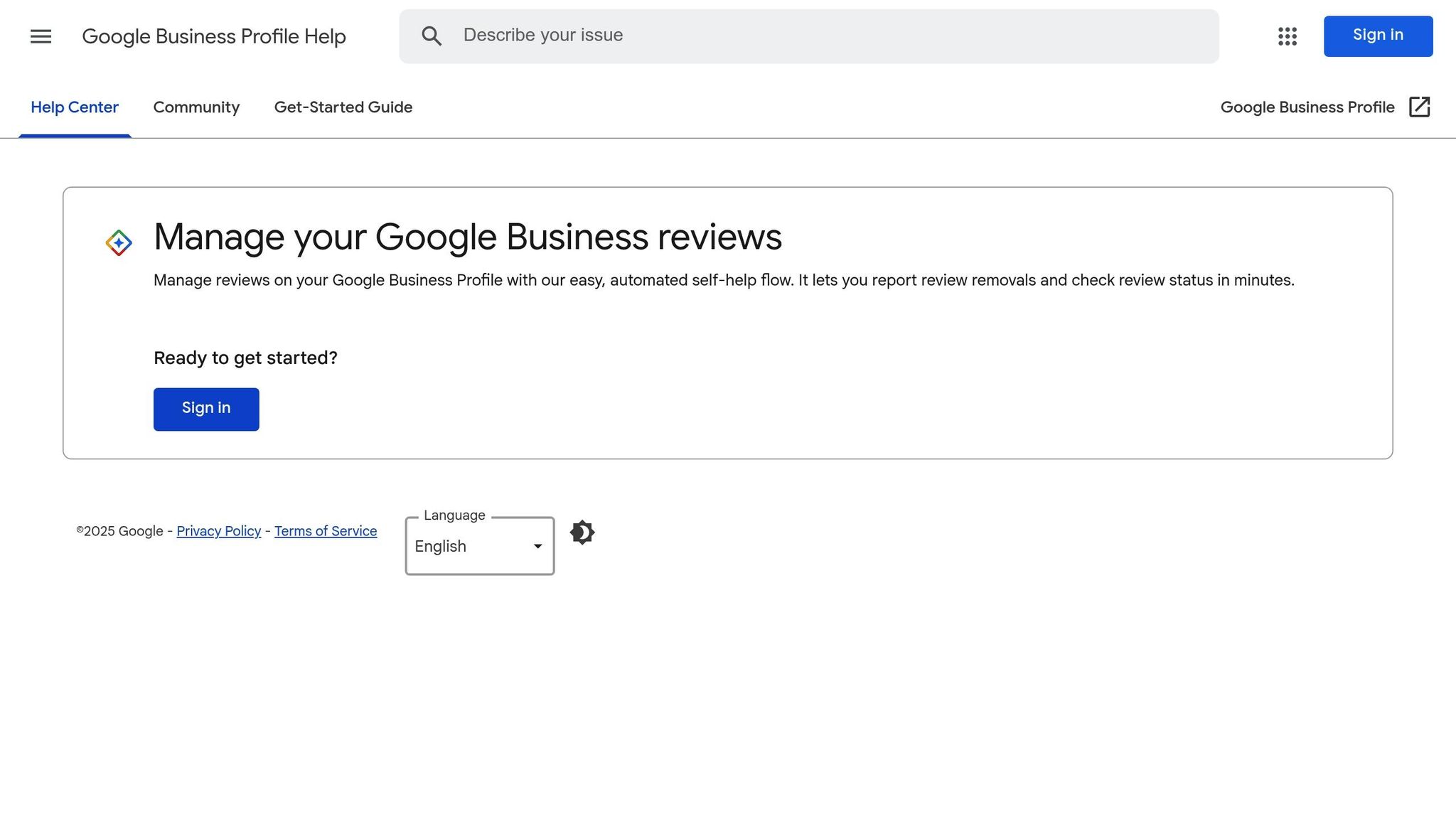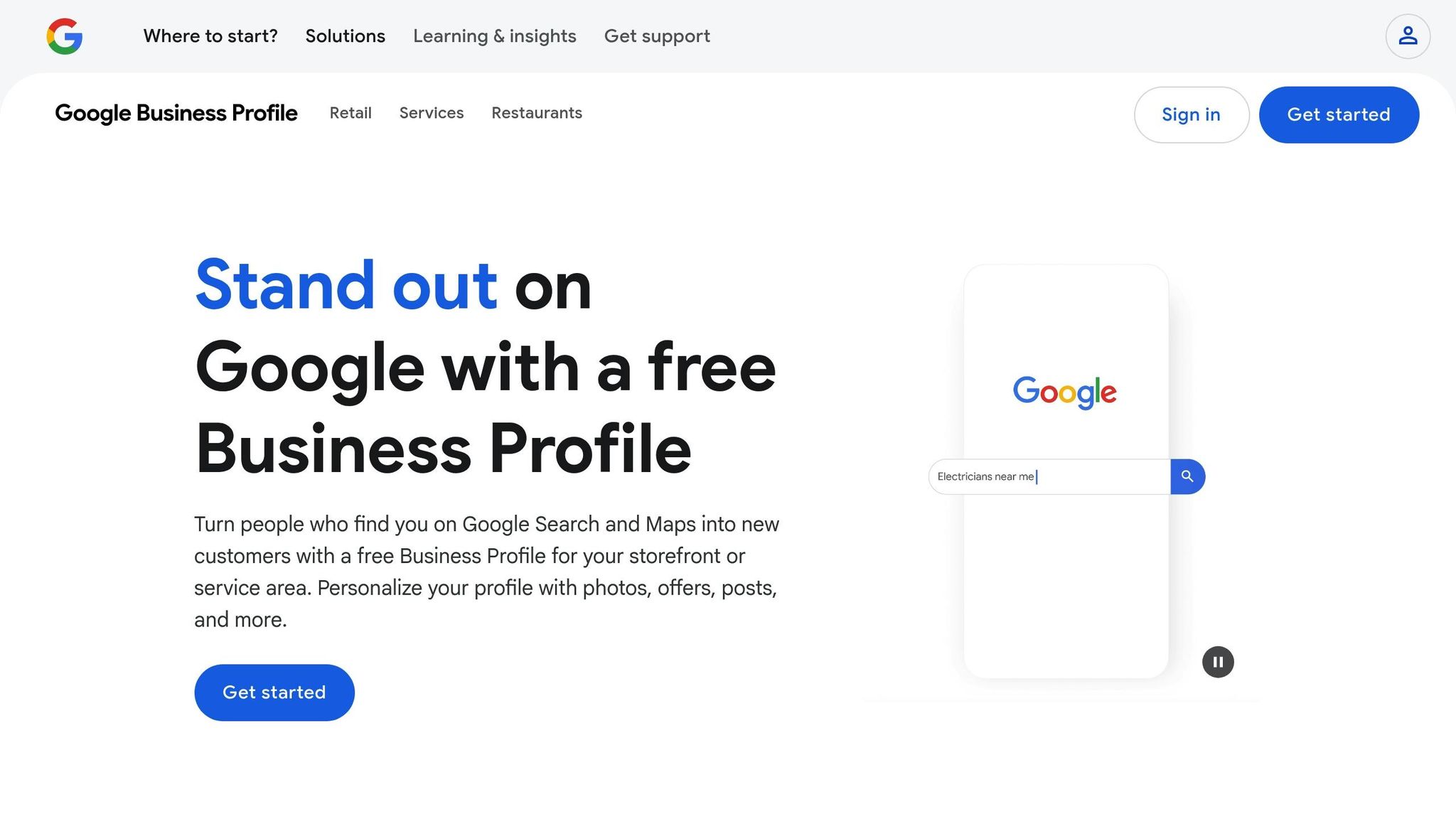Want to protect your business from harmful Google reviews? Here's how:
- Spot Problematic Reviews: Look for fake, spammy, hateful, explicit, or irrelevant content.
- Know Google’s Policies: Reviews breaking rules like sharing personal info or promoting illegal activities are flaggable.
- Report Reviews Quickly:
- On Google Maps or Search, click the three-dot menu or flag icon next to the review and follow the steps.
- Use your Business Profile Manager for detailed reporting with evidence (e.g., screenshots, timestamps).
- What Happens Next: Google may remove, keep, or request more evidence for flagged reviews.
Pro Tip: Act fast and monitor reviews daily to safeguard your reputation. Use tools like BrightLocal or Synup to stay on top of feedback.
Key Takeaway: Focus on removing policy-violating reviews, not just negative ones, to maintain trust and credibility.
How to Flag & Report Bad Google Reviews
What Makes a Google Review Inappropriate
Understanding Google's moderation process is key to identifying reviews that break the rules. Knowing what constitutes a violation helps you flag inappropriate reviews quickly and effectively.
Types of Policy Violations
Google's policies prohibit reviews that include:
- Spam or Fake Content: Reviews from bogus accounts or those filled with promotional material.
- Harassment or Hate Speech: Personal attacks, discriminatory remarks, or threats.
- Explicit Content: Sexual references or other inappropriate material.
- Private Information: Sharing personal details like phone numbers, addresses, or financial data.
- Illegal Content: Mentions of unlawful activities or products.
Below are examples to clarify these violations.
Sample Violations to Report
-
Personal Attacks
"Dr. Smith is unqualified and discloses personal details."
-
Fake Experience
"I've never visited this restaurant; I heard it's terrible. Don't waste your money!"
Legitimate vs. Inappropriate Reviews
Use the table below to distinguish between constructive feedback and reviews that violate Google's guidelines:
| Legitimate Review Traits | Signs of Inappropriate Reviews |
|---|---|
| Describes a real experience | Includes personal attacks or threats |
| Stays focused on business feedback | Shares private information |
| Maintains respectful language | Contains hate speech or profanity |
| Based on first-hand experience | Shows no direct experience, appears spammy |
| Provides useful criticism | Is irrelevant or off-topic |
How to Spot Inappropriate Reviews
Recognizing reviews that break Google's policies involves looking for clear warning signs. Here's a guide to help you evaluate reviews before deciding to flag them.
Review Google's Guidelines
Start by reviewing Google's content policies. Look for signs like abusive language or reviews that lack meaningful details.
Common Red Flags
Here are some key indicators of inappropriate reviews:
| Red Flag | What to Look For | Example |
|---|---|---|
| Generic Language | Vague comments without specifics | "This place is terrible" with no further details |
| Copy-Paste Content | Identical reviews posted across multiple listings | Same review text from different accounts |
| Irrelevant Content | Comments unrelated to the business experience | Reviews discussing unrelated political opinions |
Once you've spotted these signs, dig deeper to confirm if the review is genuinely inappropriate.
Assess the Review's Context
When evaluating flagged reviews, focus on these factors:
-
Confirm Customer Interaction
Legitimate reviews often mention specific products, services, or staff members. Look for these details to determine authenticity. -
Check the Timeline
If a review claims a visit on a day your business was closed, it's worth flagging. -
Review User History
Investigate the reviewer's profile. Be cautious if you notice patterns like:- Recently created accounts
- Profiles focused only on negative feedback
- Users who haven't reviewed any other businesses
Steps to Report Bad Reviews
Reporting Through Google Maps

To report a review directly via Google Maps, follow these steps:
- Open Google Maps and find your business listing.
- Go to the review section and locate the problematic review.
- Click the three vertical dots (⋮) next to the review.
- Select Report review from the dropdown menu.
- Choose the appropriate violation type.
- Provide any supporting details to back up your report.
"Cite the exact policy violated, like 'Google's Fake Content Policy Section 3.2,' to streamline moderation", says SEO expert Jane Doe.
If you're using Google Search instead of Maps, the process is slightly different.
Reporting Through Google Search
| Step | Action | Additional Notes |
|---|---|---|
| 1 | Search for your business name | Ensure the knowledge panel appears. |
| 2 | Click Reviews in the knowledge panel | Look for the flag icon or the three-dot menu. |
| 3 | Find the review you want to report | Double-check to select the correct review. |
| 4 | Click the flag icon (🏴) | This differs from the three-dot menu on Maps. |
| 5 | Follow the prompts for reporting | Categories are consistent across platforms. |
Using the Business Profile Manager

For a more detailed reporting process, you can use the Business Profile Manager:
- Log in to your Google Business Profile account.
- Go to the Reviews section.
- Find the review you wish to report.
- Click the three-dot menu and select Report review.
- Include detailed evidence, such as screenshots or timestamps, to support your case.
Businesses typically receive a response within 3 to 7 days. Providing solid evidence can make all the difference. For example, a restaurant in Vermont successfully removed a fake review by submitting timestamps that proved the reviewer never visited.
sbb-itb-5be333f
After You Report a Review
Once you report a review, Google may take one of the following actions:
- Remove the Review: If the review violates Google's guidelines, it will be taken down permanently.
- Keep the Review: If the review complies with their policies, it will remain visible.
- Request More Information: Google might ask you for additional evidence to support your claim.
If your request is denied, you can appeal by providing detailed and factual evidence. Keep in mind, Google protects the reviewer's anonymity, and you'll only receive the final decision without further details.
Next, explore what steps to take after reporting and how to connect with Google Support for assistance.
Getting Extra Help
If flagging inappropriate reviews doesn't solve the problem, there are other ways to safeguard your reputation. Consider using tools that make it easier to monitor and manage reviews effectively.
Review Management Tools
Review management tools can streamline the process of keeping tabs on your reviews. These platforms allow you to track feedback across multiple locations and keep detailed records of any disputes.
| Tool Name | Features |
|---|---|
| LocalEdge | Offers a variety of review management options. |
| Synup | Focuses on automating local SEO and reputation tasks. |
| BrightLocal | Provides tools for monitoring reviews and analyzing reputation. |
These tools often include automated notifications and in-depth reporting to help you stay on top of your online presence.
Conclusion
Key Takeaways
Protecting your online reputation starts with promptly spotting policy violations, collecting evidence, and reporting them through Google Maps, Search, or your Business Profile Manager. Concentrate on reviews that clearly break Google's rules, rather than those that are simply unfavorable. Legitimate negative reviews will stay if they follow Google's guidelines. The aim is to preserve genuine customer feedback while removing content that violates platform policies.
Handling Online Reviews Effectively
Quick action is important, but a well-thought-out strategy is essential for long-term success in managing your online reputation. A clear and consistent approach ensures your efforts remain effective over time.
| Action Item | Recommended Frequency |
|---|---|
| Monitor Reviews | Daily |
| Respond to Reviews | Within 24-48 hours |
| Review Google's Policies | Monthly |
| Analyze Performance | Quarterly |
A systematic approach to managing reviews not only safeguards your reputation but also builds trust with your audience. Regular monitoring and thoughtful responses to inappropriate reviews can help protect your business while fostering transparency and trust in your online presence.
The key is to balance vigilance against policy-breaking content with active engagement through customer feedback. This approach addresses problematic reviews while strengthening your overall reputation management efforts.
FAQs
How long does it take for Google to review and remove a flagged review?
The time it takes for Google to review and potentially remove a flagged review can vary. In most cases, the process may take a few days, but it could be longer depending on the volume of reports Google is handling and the complexity of the review in question.
If the flagged review clearly violates Google's policies, it is more likely to be addressed quickly. However, if additional investigation is required, the process might take more time. Be sure to provide accurate details when flagging a review to help expedite the process.
What evidence can I provide to support my claim when reporting a fake Google review?
When reporting a fake Google review, providing strong evidence can help your case. Include screenshots or photos that demonstrate the review's inaccuracy, such as proof the reviewer was never a customer or evidence contradicting their claims. If possible, share transaction records or communications that show no interaction occurred with the reviewer.
Additionally, highlight how the review violates Google's policies, such as containing spam, harassment, or false information. The more specific and factual your evidence, the better Google can evaluate your report.
Can I challenge Google’s decision if they don’t remove a flagged review?
If Google decides to keep a review that you flagged as inappropriate, you currently cannot appeal their decision. Google evaluates flagged reviews based on their content policies, and their decisions are considered final.
To ensure your flagging request has the best chance of success, make sure the review clearly violates Google's prohibited and restricted content policies. Examples include fake reviews, offensive language, or spam. For more information, consult Google’s review policies to understand what qualifies as inappropriate.


